Literary papers | Notes in the margin
Lindsay Bilodeau, Assistant Curator, shares highlights from Eleanor Catton's annotated edition of 'The Luminaries' revealing the author's reflections on her work and the thoughts and feelings behind the storytelling in her Man Booker Prize-winning novel.
Signed and annotated copy of The Luminaries
Authors may annotate their works for several reasons, sometimes the annotations are focused on editing the work for publications, sometimes for making clarifications for their editors and early readers and other times they’re reflections on the work after the fact.
Annotations are often handwritten and personal, and they can represent the thoughts of the writer (or other involved people) at the moment in which they’re working or reading. There’s something charming about scribbled notes in the margins of a book or a draft manuscript, these notes are like little windows into the thoughts of an author.
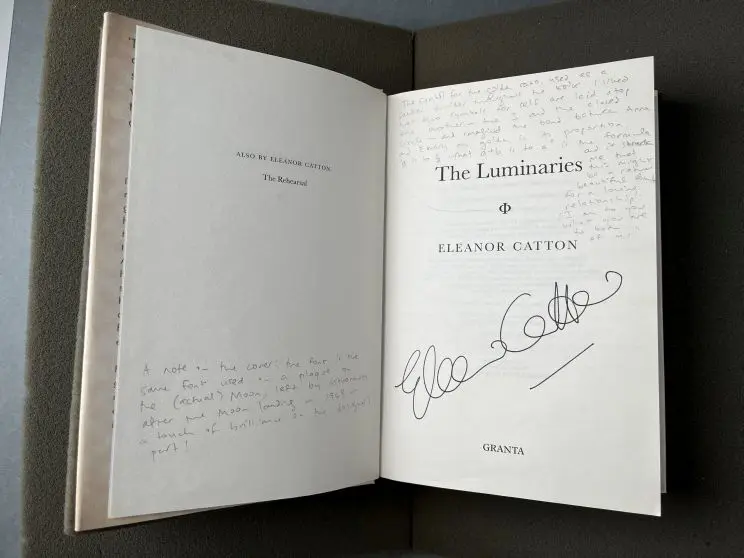
The author's signature appears on the title page along with notes written in the margins of the front matter of this annotated first edition copy of Eleanor Catton’s The Luminaries Ref: MSX-10208, Alexander Turnbull Library.
Literary annotations give us an insight into the person behind our favourite books, they may show us the way that a writer thinks, works, and what influences their works. In the case of this manuscript, an annotated first edition copy of Eleanor Catton’s The Luminaries, the annotations give insight into several facets of the work.
Annotated copy created for a charity auction
Catton retrospectively annotated a copy of her novel for a charity auction in 2021, reflecting on her work in hindsight. Her annotations remind us of the real person behind the work, and connect the stories authors write to the real world.
One of my favourite annotations is on the very first pages of the book. In it, Catton writes a note on the design of the cover of the book: “the font is the same font used on a plaque on the (actual) Moon, left by astronauts after the Moon landing in 1969 — a touch of brilliance on the designer’s part!”
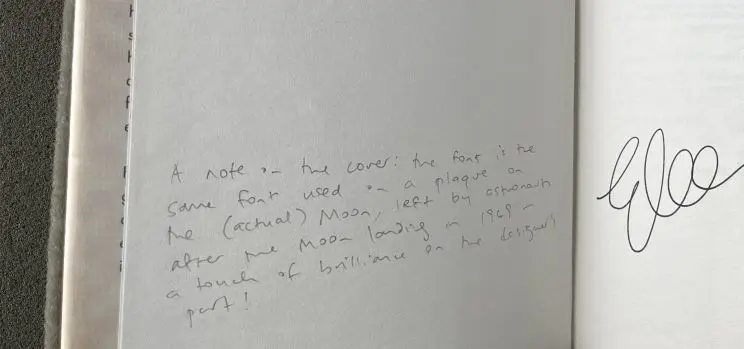
Photo of annotation about the font used in The Luminaries.
This first edition copy of Catton’s 2013 Booker Prize-winning novel The Luminaries contains over 4,000 words of annotations in its margins and was acquired by the Alexander Turnbull Library in 2022. Catton is one of only two writers from Aotearoa to have won a Booker, the other being Keri Hulme, who won in 1985 with her book the bone people (of which we also hold an annotated copy — ATL-Group-00788.
Catton's annotations fall into three categories
When I sat down to look through this particular manuscript collection item, I was struck by the different kinds of annotations Catton added to her novel. To me, the annotations, that stand out, fall into three categories:
personal annotations which show Catton’s connections to her family
those that highlight how much time and thought she put into the research behind the story, and
astrology-related annotations.
Personal notes
Perhaps the most touching annotations in this collection item, are the more personal notes that Catton has included. For example, an annotation on the dedication page of the novel, provides more details on the inspirations for the book. Catton notes, “When I was in high school I cycled with [my father] from Christchurch to Hokitika [...] that became one of the earliest idea-germs of this book.”
This annotation goes on to explain further why she dedicated the work to her parents and shows how deeply her childhood and her experience of being raised by them impacted The Luminaries.

Personal annotation is found on the dedication page of the novel.
Later in the book, on page 198 she writes in the margin “Gemini again. (My father’s sign so I have a particular affinity with this one),” Showing how her personal life, and especially her father, influenced the book and the ways she wove herself and her family into the novel.
These sorts of personal annotations give the reader a window into Catton’s personal life, and quite sweetly remind us of her parents’ role in the creation of the novel’s story.
Thoughtfulness and research
Another theme that emerges in Catton’s annotations is just how much research and thought she put into the novel. As someone who gets to work with historical material every day, and who finds our collections at the Alexander Turnbull Library fascinating, it charmed me to see that she must have spent a lot of time looking through archival material in her writing process.
Catton, in the margins, can point out her use of anachronisms, for example referring to the “Tasman Sea” which, according to her annotations, was not called the Tasman in 1866, when the novel opens.
Catton’s annotations also contest a letter she received criticising her for using an anachronism, using her knowledge of map-making processes in the nineteenth century. The annotation says "I received a very cross letter from a reader about this anachronism but in fact, weather maps of this kind were just starting to be used in 1866."
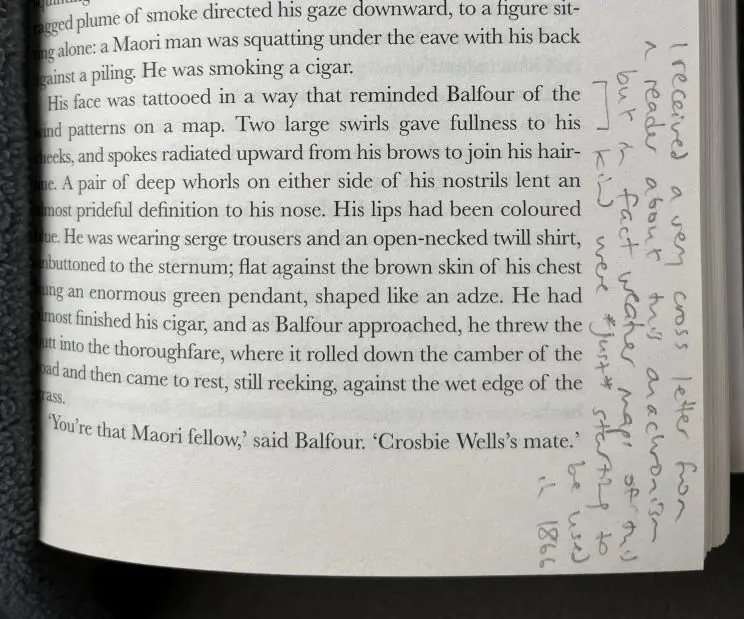
An annotation contesting a letter Catton received criticising her for using an anachronism.
Astrology
For anyone who’s read The Luminaries, it will likely be unsurprising that a large portion of Catton’s annotations relate to astrology. The entire novel, as she has spoken about frequently in interviews, is structured using astrology. Her annotations serve to expand on these influences, showing just how in-depth her use of astrological tropes and terms truly are in the novel. Many annotations highlight sections of text as showing the traits of a particular sign, reading, for example, “Libra temperament” or “Gemini trait”.
Others are more in-depth, for example, in an early part of the novel Catton’s annotations explain how Walter Moody’s character is representative of Mercury, and as such his presence changes the mood of scenes.
The reader sees this within the first few pages of the novel when Moody enters the smoking room at the Crown Hotel and the ensemble cast of twelve men suddenly find their behaviour — and purpose for being in the room — altered. In astrology, Catton notes, this sort of mood or behaviour-altering influence is common when Mercury comes into play.
Catton’s annotations even go so far as to note that Moody’s name itself highlights his mercurial role, writing that when you remove the first and last letters of his name it becomes “alter mood”.
I loved reading the annotations about her use of astrology and seeing how her understanding of astrology influenced the book. Though there are plenty of interviews and reviews of the novel that discuss Catton’s astrological inspirations, it is such a unique experience to see how she highlights particular moments, characters, and excerpts and explains how astrology plays into them.
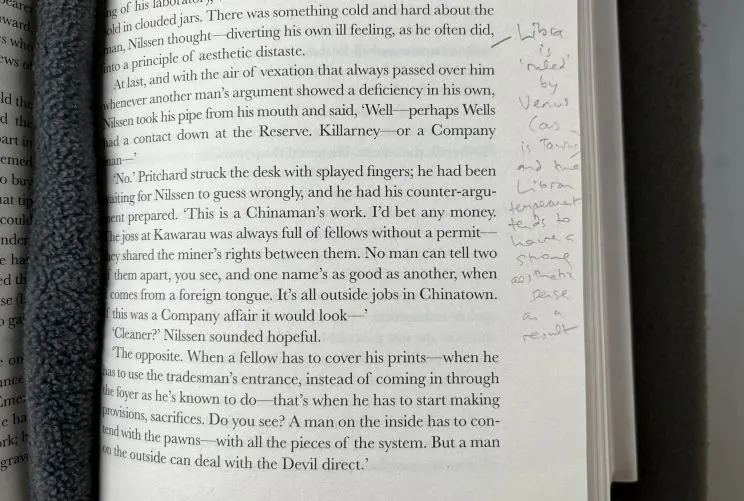
Catton's annotation notes, "Libra is 'ruled' by Venus (as is Taurus) and the Libra temperament tends to have a strong aesthetic sense as a result" and this was written in response to a line in the novel, "There was something cold and hard about the man, Nilssen thought—diverting his own ill feeling, as he often did, into a principle of aesthetic distaste."
Catton's extensive use of Papers Past
Throughout the annotations, she references the kinds of archival material she used, including by highlighting a passage in which she describes a real nineteenth-century newspaper she looked at in her research.
Catton noted in interviews, when the book was first published, that she made use of the National Library’s resource Papers Past. She was quoted in a blog that we published as saying: “By far the most helpful non-fictional resource was the National Library of New Zealand’s newspaper archives, which has digital copies of every edition of the West Coast Times, the Lyttelton Times, and Otago Witness, among a great many other newspapers and periodicals.”
You can read more about Catton’s use of Papers Past in NZ literature at Turnbull: looking back, looking forward.
Annotated references
The annotations also give an insight into how intricately Catton plotted the novel and its references. For example, on page 204 her annotation states: “[a]ll of the important plot elements in this book have a twin of sorts — so there is a real widow and a typographical widow, a deed of gift and a deed of sale, two instances of the letter ‘C’, two ..., two signatures.” Showing the reader how aware she is, even nearly a decade after the novel was written, of the plot elements and the sort of story she was trying to write.
Conclusion
The annotations in this collection item offer a wealth of knowledge for any reader. It is particularly exciting, with there being no other access to Catton’s literary papers, to see how she thinks about her works. Whether you’re reading The Luminaries for the first time, or you’re a die-hard fan, Catton’s handwritten notes will expand your understanding of not only the content of the novel but of the author herself.
The themes I’ve pulled from the annotations are representative of my experience working with this item, but there’s so much more to discover. I can’t wait to see what takeaways researchers and readers will have when they view this object for themselves.
View the annotated copy of The Luminaries
This copy of The Luminaries (MSX-10208) and many other incredible collection items can be viewed in the Katherine Mansfield Reading Room 10am to 5pm, Monday to Friday and 9am to 1pm, Saturday.
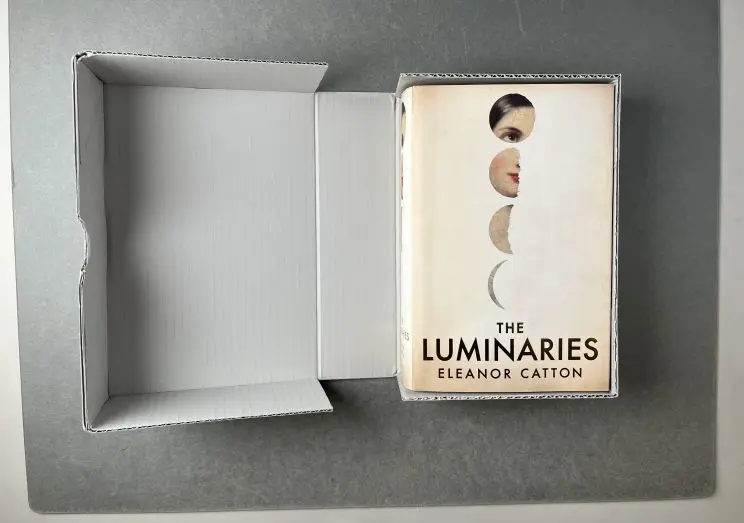
An annotated and signed first edition copy of Eleanor Catton’s The Luminaries.
Literary Papers blog series
The Literary Papers blog series highlights collection items from the Manuscripts Collection at the Alexander Turnbull Library.